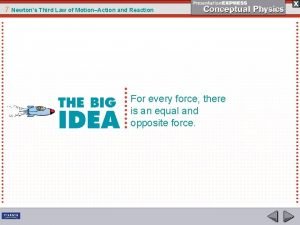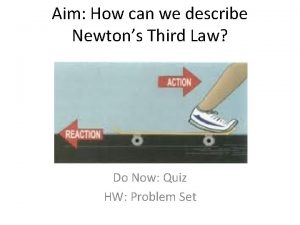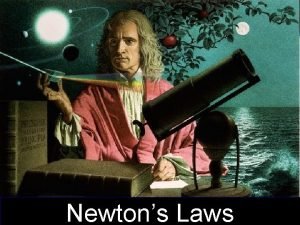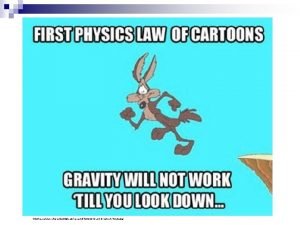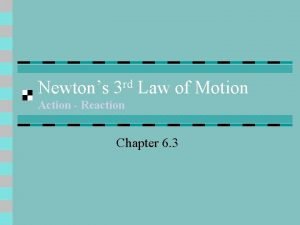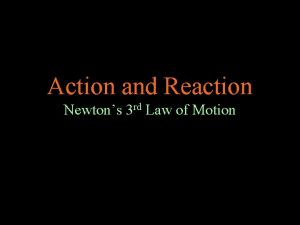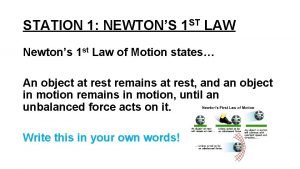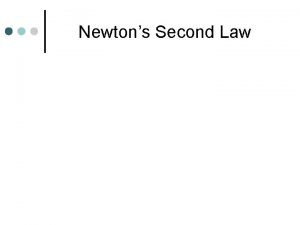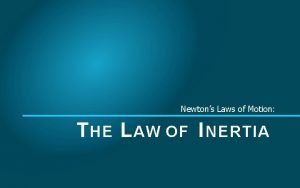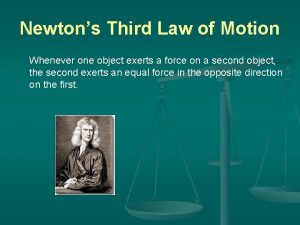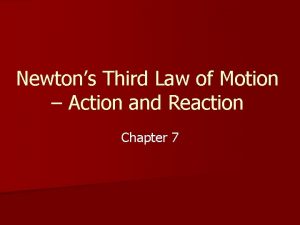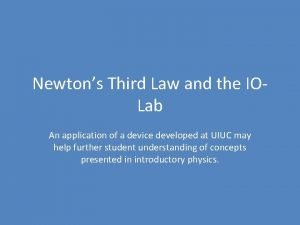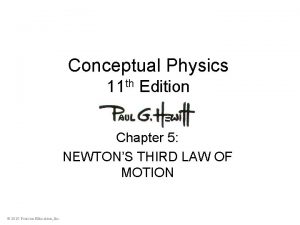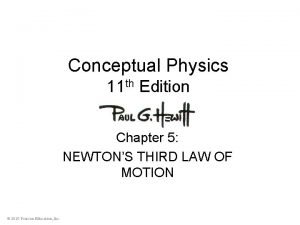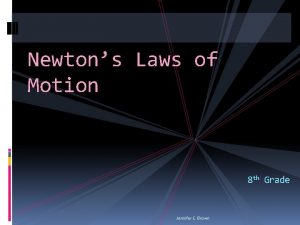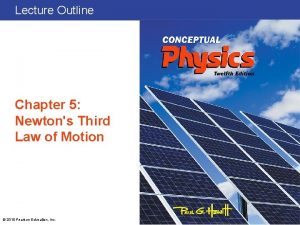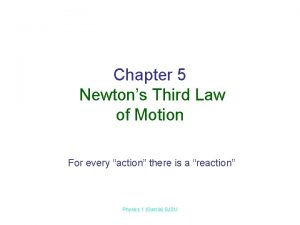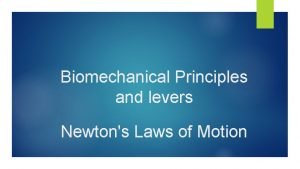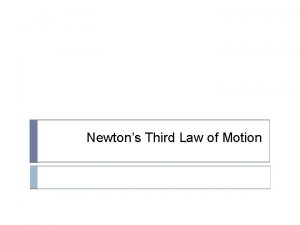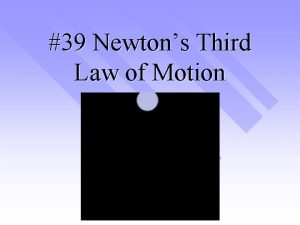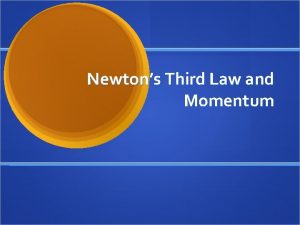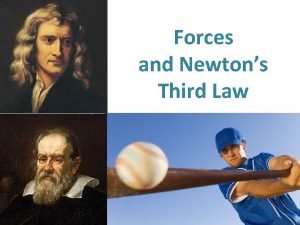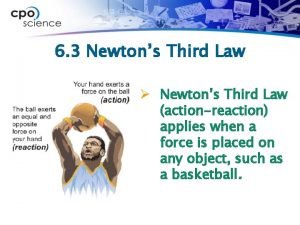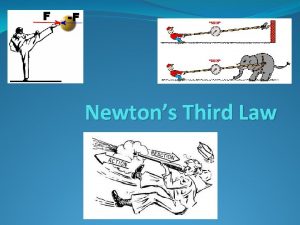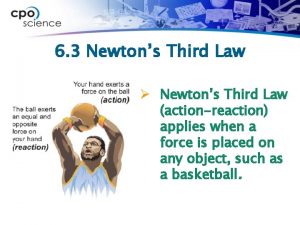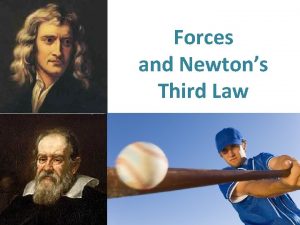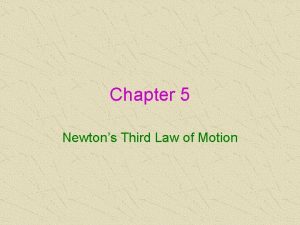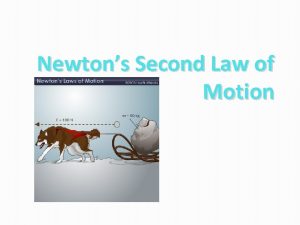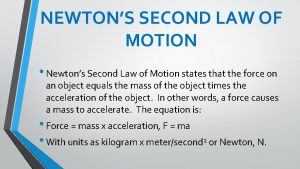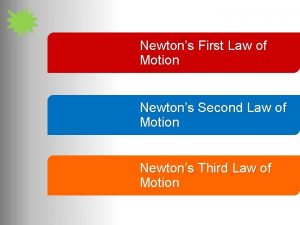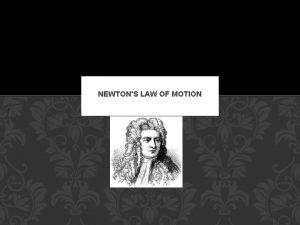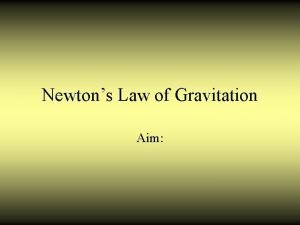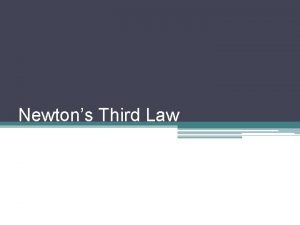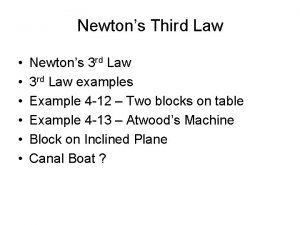The Third Law of Motion 1 Newtons Third
































- Slides: 32

The Third Law of Motion

• 1. Newton’s Third Law of Motion –

• 1. Newton’s Third Law of Motion – – To every action force there is an equal and opposite reaction force

• 1. Newton’s Third Law of Motion – – To every action force there is an equal and opposite reaction force – When one object exerts a force on a second object, the second one exerts a force on the first that is equal in size and opposite in direction

• 1. Newton’s Third Law of Motion – – To every action force there is an equal and opposite reaction force – When one object exerts a force on a second object, the second one exerts a force on the first that is equal in size and opposite in direction – Forces are equal, but they are NOT balanced

• 1. Newton’s Third Law of Motion – – To every action force there is an equal and opposite reaction force – When one object exerts a force on a second object, the second one exerts a force on the first that is equal in size and opposite in direction – Forces are equal, but they are NOT balanced – Examples: trampoline, swimmer, rocket propulsion

Newton’s Laws • 1. First Law – (inertia) – an object moving at a constant velocity keeps moving at that velocity unless a net force acts on it; an object at rest stays at rest unless a net force acts on it

Newton’s Laws • 2. Second Law – (f = m x a) – a net force acting on an object causes the object to accelerate in the direction of the net force

Newton’s Laws • 3. Third Law – (action-reaction pairs) – To every action force there is an equal and opposite reaction force

• 2. Gravity and the planets –

• 2. Gravity and the planets – – The orbit of every planet is affected by the gravitational pulls from all the other planets

• 3. Momentum–

• 3. Momentum– – A property that a moving object has because of its mass and velocity (speed&direction)

• 3. Momentum– – A property that a moving object has because of its mass and velocity (speed&direction) – Momentum is related to how much force is needed to change the motion of a moving object

• 3. Momentum– – A property that a moving object has because of its mass and velocity (speed & direction) – Momentum is related to how much force is needed to change the motion of a moving object – Increasing either the speed or the mass of an object makes it harder to stop


• 4. Calculating Momentum –

• 4. Calculating Momentum – – momentum = p

• 4. Calculating Momentum – – momentum = p – momentum = mass x velocity

• 4. Calculating Momentum – – momentum = p – momentum = mass x velocity –p=mxv

• 5. Rewrite Newton’s 2 nd Law –

• 5. Rewrite Newton’s 2 nd Law – – Recall, a=(vf-vi)/time

• 5. Rewrite Newton’s 2 nd Law – – Recall, a=(vf-vi)/time – Recall, f = m x a

• 5. Rewrite Newton’s 2 nd Law – – Recall, a=(vf-vi)/time – Recall, f = m x a – Combine these relationships -

• 5. Rewrite Newton’s 2 nd Law – – Recall, a=(vf-vi)/time – Recall, f = m x a – Combine these relationship • Net force = (change in momentum)/time

• 5. Rewrite Newton’s 2 nd Law – – Recall, a=(vf-vi)/time – Recall, f = m x a – Combine these relationships • Net force = (change in momentum)/time • F = (mvf - mvi) / time

• 5. Rewrite Newton’s 2 nd Law – – Recall, a=(vf-vi)/time – Recall, f = m x a – Combine these relationships • Net force = (change in momentum)/time • F = (mvf - mvi) / time – (mvf=final momentum, mvi=initial momentum)

• 6. Law of Conservation of Momentum –

• 6. Law of Conservation of Momentum – – Momentum of an object doesn’t change unless it mass, velocity, or both change

• 6. Law of Conservation of Momentum – – Momentum of an object doesn’t change unless it mass, velocity, or both change – HOWEVER, momentum can be transferred from one object to another

• 6. Law of Conservation of Momentum – – Momentum of an object doesn’t change unless it mass, velocity, or both change – HOWEVER, momentum can be transferred from one object to another – The Law states that if a group of objects exerts forces only on each other, their total momentum doesn’t change

 Newton's third law
Newton's third law Newton's 3 laws of motion
Newton's 3 laws of motion Newton's third law
Newton's third law Describe newtons third law
Describe newtons third law Newtons third law of thermodynamics
Newtons third law of thermodynamics Newton's law
Newton's law Studyja
Studyja Newtons 3 rd law of motion
Newtons 3 rd law of motion Newtons 3 rd law of motion
Newtons 3 rd law of motion Rd law
Rd law Newton's first law meme
Newton's first law meme Newtons 3 rd law of motion
Newtons 3 rd law of motion Newtons 3 rd law
Newtons 3 rd law Newtons 3 rd law of motion
Newtons 3 rd law of motion Newtons first law
Newtons first law What's newtons second law of motion
What's newtons second law of motion Neetons second law
Neetons second law Newtons law of motion
Newtons law of motion Newton's first law and second law and third law
Newton's first law and second law and third law Newton's first law and second law and third law
Newton's first law and second law and third law 3 newton's laws
3 newton's laws Newtons third aw
Newtons third aw Newton's third law of motion examples
Newton's third law of motion examples According to the third law of motion action and reaction
According to the third law of motion action and reaction Gadgets based on newton's third law of motion
Gadgets based on newton's third law of motion First law of motion facts
First law of motion facts Slightly tilted wings of airplanes deflect
Slightly tilted wings of airplanes deflect Conceptual physics chapter 5 newton's third law of motion
Conceptual physics chapter 5 newton's third law of motion According to the third law of motion, action and reaction
According to the third law of motion, action and reaction Law of motion 3rd
Law of motion 3rd Slightly tilted wings of airplanes deflect
Slightly tilted wings of airplanes deflect Site:slidetodoc.com
Site:slidetodoc.com Newton's law of motion biomechanics
Newton's law of motion biomechanics

